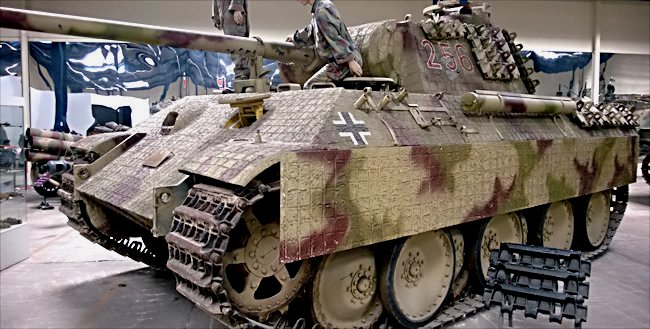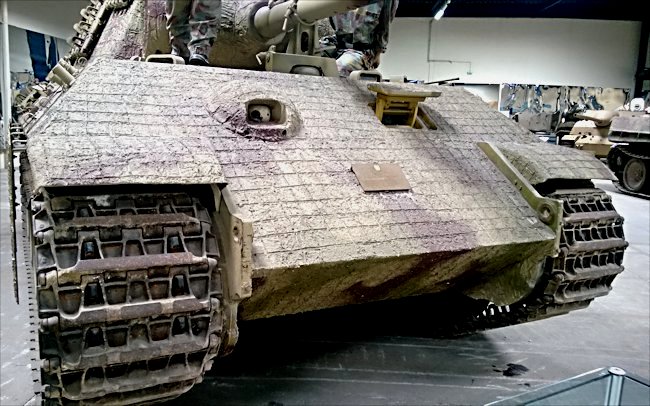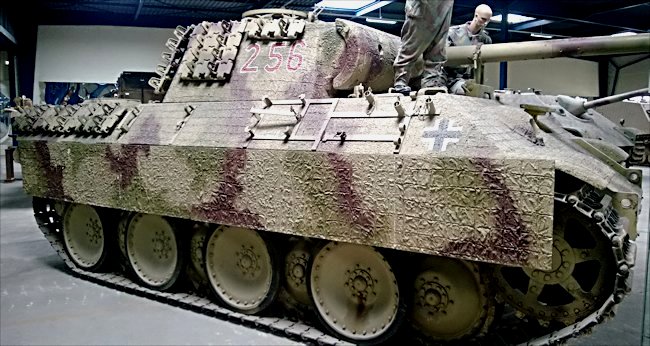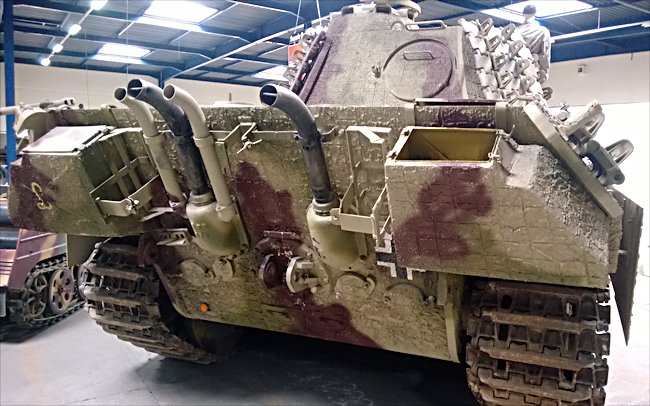The Panther Ausf. A Medium Tank
This Panzer V Panther Tank Ausf. A Medium Sd.Kfz.171 can be found at the French Tank Museum in Saumur in the Loire Valley. Spare tank tracks have been placed on the sides of the hull and turret as they would have been during WW2 to give some extra protection on weaker armoured areas, from shell or Bazooka fire. This Panzer V tank is painted with the divisional marking of the 130th Panzer-Lehr-Division that fought with Panther tanks in Normandy and in the Ardennes.

German WW2 Panther Ausf A Medium Tank Panzerkampfwagen V
The Museum is called Musée des Blindés ou Association des Amis du Musée des Blindés, 1043, route de Fontevraud, 49400 Saumur, France www.museedesblindes.fr . The word Blindés means armoured. It has been restored using the Zimmerit-Schutzbelag anti-magnetic mine covering that was used on Panther tanks on the Western and Eastern fronts. That is what the cris-cross pattern in the bodywork camouflage is. It is a poor restoration as the Zimmerit was applied in horizontal lines not squares.
This panther is missing its front hull machine gun. The turret comes from another Panther hull (Fahrgestell number 152451), which is currently preserved in the Omaha Overlord Museum, Colleville-sur-mer, France. After the World War Two some German Panther tanks (including this one) and a Tiger tank were used in the French '6eme Regiment de Cuirassier' based in Treve, Germany. Six Panthers and one Tiger tank were used operationally by the 2nd Squadron from the French 6eme Regiment de Cuirassier.
When the regiment left Treve in 1960 for Indochina (Vietnam, Laos and Cambodia) they transferred the German tanks to the French tank builder AMX (Atelier de Construction d'Issy-les-Moulineaux) tank development centre in Satory where they were used for testing. In 1965 they are transferred to a little military museum and then in 1968-70 they were transported to the French Tank Museum in Saumur. This is the reason why Saumur had so many Panther tanks.

German WW2 Panther Ausf A Medium Tank Panzerkampfwagen V
The French Panther Tanks were used by the French Army for a limited evaluation period and were never regarded as a serving combat ready unit. The French '6eme Regiment de Cuirassier' was a cavalry regiment. The 503e RCC French Army regiment was also equipped with German Panther tanks. Neither regiment fielded more than a full squadron of German tanks at a time. The Panther's were used for as long as ammunition, spare parts or mechanical reliability held out.
Strong armour can kill you!
German tank crews would talk about the chances of survival in different tanks. Many said they would prefer to be in a Panzer Mk IV tank if you had to be hit by an enemy shell because there is a better chance it would come in and go out. The problem of being hit in a Panther tank via the weaker armoured side or rear was that the enemy’s shell would not be able to escape due to the thicker armour. It would ricochet, pinging around the inside, killing crew members.

German WW2 Panther Ausf A Medium Tank Panzerkampfwagen V
Panther Tanks foiled British tactics
Lieutenant Peter Balfour of the Scots Guards recalled the British Armoured tactics they practiced again and again on Salisbury Plain before D-Day. A attack would be preceded by a massive air or artillery bombardment. The infantry would then capture key ground and the armour would be ordered to pass through. "Well in Normandy we would get to the place and the armour would sweep through but about 200 yards down the road we would meet a couple of Panther tanks who would quickly brew up the first six Shermans and there the matter would remain". The Shermans were just out classed by the superior Panther tank. The shells just bounced off the front slopping armour.
Panther Tank crew’s joke
The only way a Sherman tank with a normal 75mm gun could destroy a German Panther tank was if it could hit them in a vulnerable spot at the side or rear. They also had to be close. The Allies superiority in numbers worked to their advantage. Whilst the crew of the Panther was engaged with fighting tanks firing at them from their left others in the squadron would try to get around the right side of the Panther for a clear up close shot. This did not always work.
German Black humour claimed that a Panther tank could knock out ten Sherman tanks. "Ja," was the ironic reply, "but they always have eleven!"

German WW2 Panther Ausf A Medium Tank Panzerkampfwagen V
There is a way to kill a Panther Tank
Sydney Radley-Walters of the Canadian Sherbrook Fusiliers found he could kill a Panther tank from the front, only if you could get your shell to hit a four to five foot strip of armour directly beneath the gun mantle. This was the "lucky shot" some tank crews talked about. It produced a favourable entry point by bouncing a round from above into the thin armour covering the driver and co-driver, in most cases killing or badly wounding both and knocking out the tank. He destroyed nineteen.
What made the Panther Tank Ausf.A different?
The panther tank variation called Ausf.A was the second version of the Panzer V to come off the production line. It had a cast rounded cupola on top of the turret rather than the harder to manufacture welded version. It was now equipped with seven periscopes to assist in threat perception and target location. Additional side armour plating over the tracks became standard

German WW2 Panther Ausf A Medium Tank Panzerkampfwagen V
US 57mm anti-tank gun Vs the Panther tank
Early morning on 20th December 1944, during the battle of the bulge, 12th SS Panzer-Division resumed their attack towards Wirtzfeld. American artillery fire scattered the German attack. Two Panther tanks were destroyed by US 57mm anti-tank guns defending the American 2nd Battalion’s Command post. The gunners fired at point blank range aiming at the rear of the panther tanks and the flames emitted by the Panther’s exhausts which gave them away in the dark.
Normally if the Panther tank crew pointed the front of their tank at the US 57mm anti-tank gun the crew would be safe. The slopping amour would normally deflect any incoming shells and bounce them away. Properly concealed outdated anti-tank guns can still be effective if used against tanks weak spots.
Where can I find other preserved Panther Tanks?
- Panther Ausf. A - Wheatcroft Collection, England
- Panther Ausf. A - Befehlspanzer Munster Germany (running condition)
- Panther Ausf. A - (n° 224) Auto + Technik Museum, Sinsheim, Germany
- Panther Ausf. A - (n° 243) Auto + Technik Museum, Sinsheim, Germany
- Panther Ausf. A - (n° 413) Private Collection, Germany
- Panther Ausf. A - (n° 256) Saumur Tank Museum France
- Panther Ausf. A - (n° 211) Saumur Tank Museum France (running condition)
- Panther Ausf. A - Omaha Overlord Museum, Colleville-sur-Mer, France
- Panther Ausf. A - 501/503e RCC Mourmelon-le-Grand France
- Panther Ausf. A - (n° 201) Royal Jordanian Tank Museum, Jordan
- Panther Ausf. A - Australian Armour and Artillery Museum, Cairns, Queensland.
- Panther Ausf. A - National Armor and Cavalry Museum, Fort Benning, GA,USA
- Panther Ausf. A - U.S. Army Ordnance Museum, Fort Lee, VA, USA
- Panther Ausf. A - The Collings Foundation, Stow, MA, USA (running condition)
- Panther Ausf. A - Canadian War Museum (CWM) in Ottawa Canada
- Panther Ausf. A or D Panzermuseum, Thun, Switzerland
- Panther Ausf. D - Breda Netherlands
- Panther Ausf. G - Bovington Tank Museum England (British Built)
- Panther Ausf. G - Wehrtechnische Dienststelle, Trier, Germany (British Built)
- Panther Ausf. G - Privately owned now confiscated by police, Germany (British Built)
- Panther Ausf. G - National War and Resistance Museum, Overloon Netherlands
- Panther Ausf. G - Houffalize Belgium
- Panther Ausf. G - Grandmenil Belgium – engine, gearbox and transmission are present
- Panther Ausf. G - Celles Belgium
- Panther Ausf. G - (n° 332) Saumur Tank Museum France
- Panther Ausf. G - Kubinka Tank Museum Russia (running condition)
- Panther Ausf. G - U.S. Army Ordnance Museum, Fort Lee, VA, USA
- Panther Ausf. G - 2x National Armor and Cavalry Museum, Fort Benning, GA, USA
- Source - Pierre-Oliver Buan - http://the.shadock.free.fr/Surviving_Panzers.html
WW2 tank books

